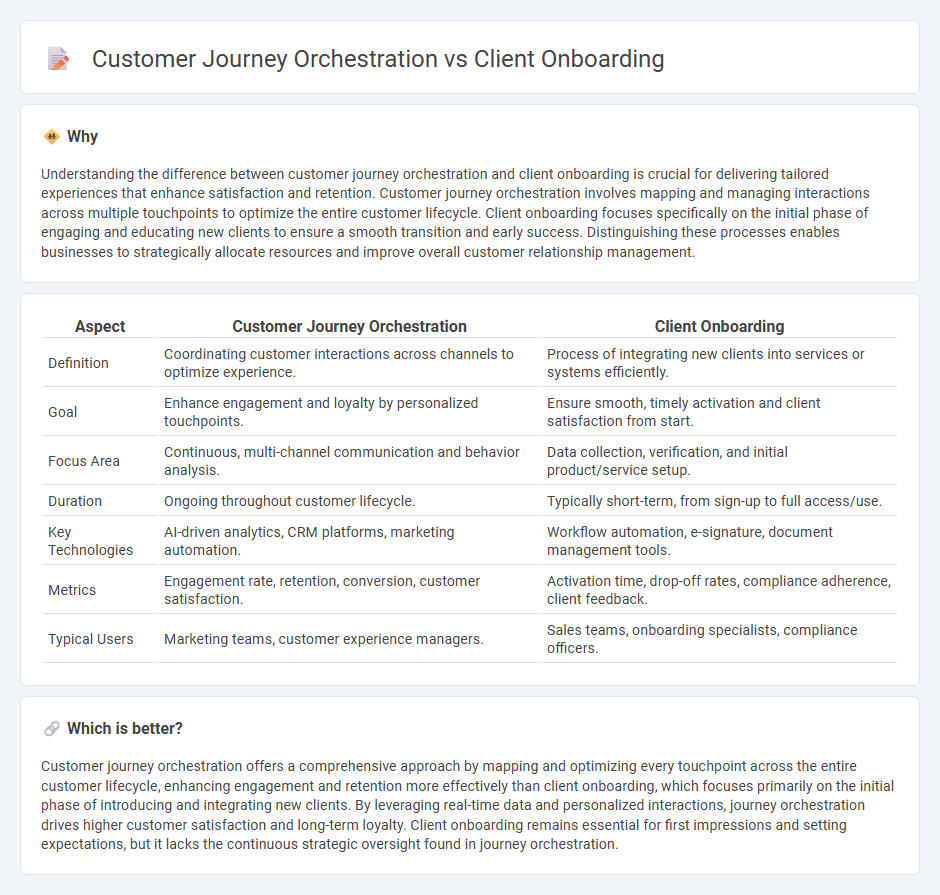
Customer journey orchestration focuses on tailoring interactions across multiple touchpoints to create a seamless, personalized experience, whereas client onboarding prioritizes efficiently integrating new clients into a company's systems and processes. Both strategies aim to enhance customer satisfaction and retention by addressing different phases of the client relationship lifecycle. Explore more to understand how combining these approaches can drive business growth.
Why it is important
Understanding the difference between customer journey orchestration and client onboarding is crucial for delivering tailored experiences that enhance satisfaction and retention. Customer journey orchestration involves mapping and managing interactions across multiple touchpoints to optimize the entire customer lifecycle. Client onboarding focuses specifically on the initial phase of engaging and educating new clients to ensure a smooth transition and early success. Distinguishing these processes enables businesses to strategically allocate resources and improve overall customer relationship management.
Comparison Table
| Aspect | Customer Journey Orchestration | Client Onboarding |
|---|---|---|
| Definition | Coordinating customer interactions across channels to optimize experience. | Process of integrating new clients into services or systems efficiently. |
| Goal | Enhance engagement and loyalty by personalized touchpoints. | Ensure smooth, timely activation and client satisfaction from start. |
| Focus Area | Continuous, multi-channel communication and behavior analysis. | Data collection, verification, and initial product/service setup. |
| Duration | Ongoing throughout customer lifecycle. | Typically short-term, from sign-up to full access/use. |
| Key Technologies | AI-driven analytics, CRM platforms, marketing automation. | Workflow automation, e-signature, document management tools. |
| Metrics | Engagement rate, retention, conversion, customer satisfaction. | Activation time, drop-off rates, compliance adherence, client feedback. |
| Typical Users | Marketing teams, customer experience managers. | Sales teams, onboarding specialists, compliance officers. |
Which is better?
Customer journey orchestration offers a comprehensive approach by mapping and optimizing every touchpoint across the entire customer lifecycle, enhancing engagement and retention more effectively than client onboarding, which focuses primarily on the initial phase of introducing and integrating new clients. By leveraging real-time data and personalized interactions, journey orchestration drives higher customer satisfaction and long-term loyalty. Client onboarding remains essential for first impressions and setting expectations, but it lacks the continuous strategic oversight found in journey orchestration.
Connection
Customer journey orchestration enhances client onboarding by mapping personalized touchpoints that guide new clients through tailored experiences, increasing engagement and satisfaction. Effective orchestration aligns onboarding processes with customer behaviors and preferences, ensuring timely communication and seamless transitions between stages. This integration boosts retention rates and accelerates value realization by fostering meaningful connections from the initial interaction.
Key Terms
**Client Onboarding:**
Client onboarding is the structured process that ensures new clients are smoothly integrated into a company's services through personalized communication, compliance verification, and tailored support. Optimizing client onboarding reduces churn rates and accelerates time-to-value by delivering clear, consistent touchpoints from initial contract to full product adoption. Explore deeper strategies and tools to enhance your client onboarding effectiveness for sustainable growth.
Intake Process
Client onboarding optimizes the intake process by streamlining data collection and ensuring seamless integration of client information into CRM systems. Customer journey orchestration focuses on mapping and managing personalized interactions throughout the lifecycle, enhancing engagement and retention. Explore effective strategies to master intake processes and improve overall client experience.
Needs Assessment
Client onboarding centers on accurately capturing initial client needs through structured needs assessment, ensuring tailored solutions from the outset. Customer journey orchestration leverages dynamic needs assessment throughout multiple touchpoints to continuously adapt and enhance personalized experiences. Discover how integrating needs assessment optimizes both onboarding success and holistic customer engagement.
Source and External Links
8 Step Client Onboarding Process with Templates - ClickUp - Client onboarding is the process of integrating new clients and establishing a productive relationship, involving setting clear expectations, personalizing the experience, automating tasks, ensuring smooth knowledge transfer, focusing on communication, delivering quick wins, and measuring success continuously.
What is Client Onboarding? - DealHub - Client onboarding is the process of welcoming new clients, addressing their queries, setting expectations, and maintaining transparency with personalized touches and software automation to ensure a seamless, stress-free experience.
Client Onboarding Guide: 8 Steps to Happy Relationships - Ignition - Client onboarding is a foundational process for building trust, setting expectations, and delivering a smooth experience, including contract signing, collecting key client information, automating tasks, and gathering feedback for ongoing improvement.
 dowidth.com
dowidth.com